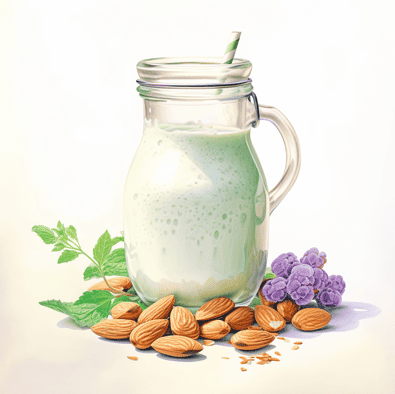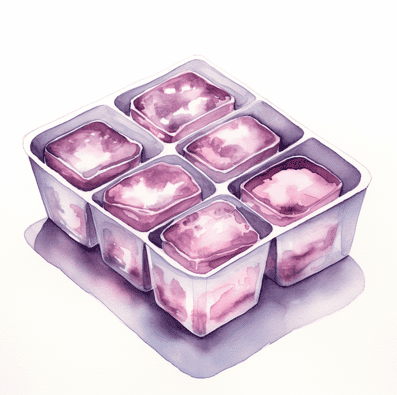
Learn how to freeze almond milk and make your busy life just a bit easier. Especially when your a carton of almond milk nearing its end and thought. For best results, don’t just read how to freeze almond, but how to thaw and store the defrosted milk after.
Hi, I’m Hazel
I gave up on skincare after years of issues with acne and sensitive skin.
But after going plant-based, my skin cleared up and even started to glow. Now I help women reveal their natural beauty with simple, delicious plant-based food.
I also used to be a nurse, and love nerding out on nutritional science (high-quality science, that is).

As usual, this post is based on the strongest nutritional evidence I could find with a focus on the simplest, most delicious foods
…because who has time to waste on actions that don’t work?
The quick version:
To safely freeze almond milk, pour it into freezer-safe containers, leaving about an inch of space at the top to allow for expansion, and store it in the freezer. Or even better, freeze in ice-cube trays.
When ready to use, thaw it in the refrigerator overnight and shake or blend well to restore its texture.

The best way to freeze almond milk
Avoid freezing almond milk in large containers. Instead, freeze in smaller amounts or even ice-cubes that you can use at once to ensure freshness and convenience every time you thaw it.
Almond milk cubes
Almond milk ice cubesare aperfect for dropping into your morning coffee or blending into smoothies or dairy-free ice cream for that instant chill without dilution.

Choose Your Tray: Select clean ice cube trays. If you prefer larger blocks of frozen almond milk, you can use larger moulds or even small freezer-safe containers.
Fill the Trays: Pour the almond milk into the ice cube trays. Use a spoon or a small pitcher for better control and to prevent spills. Fill each compartment about 90% full, leaving some space at the top for the milk to expand as it freezes.
Freeze: Place the trays in the freezer. Make sure they are level so the almond milk freezes evenly.
Freezing Time: Allow the almond milk to freeze solid. This usually takes about 4-6 hours, but it can vary depending on your freezer’s temperature settings.
Storage: Once the almond milk cubes are frozen, you can transfer them to a freezer-safe bag or container to save space in your freezer. Label the freezer bag with the date so you can keep track of how long they’ve been stored!
Use: To use, simply take out as many almond milk ice cubes as you need and add them directly to smoothies, coffee, or cooking recipes. They melt quickly when added to warm dishes or beverages.
Keeping ice cube trays filled with frozen cubes of almond milk is a simple way to make the most of any surplus of almond milk you might have. They are also easier to store in a freezer compared to large chunks of milk.
You may also like: Slimming Down: Is Soy Or Almond Milk Better?
Freezing a large amount of almond milk

Preparation
This involves selecting the right freezer-safe container. You want something that will handle the expansion of milk as it freezes without spilling over. This step is crucial to maintain the quality and usability of your frozen almond milk.
Pouring
Be mindful to leave a bit of space at the top of each container. This space allows the small amounts of almond milk to expand when it freezes, preventing any mess in your freezer and ensuring easy storage.
Storage
Place your containers in the coldest part of your freezer to help the almond milk freezes evenly and quickly. This quick freeze helps preserve its texture and taste, making it the best way to enjoy frozen almond milk whenever you need it.
You may also like:
Breakout or Breakthrough? Is Almond Milk Good for Acne?
Can you freeze almond milk in its original container?
Freezing almond milk in its original container is not recommended, especially if it’s a carton or a plastic jug that isn’t designed for freezer storage.
Here are the reasons why and what you can do instead:
- Expansion: Like many liquids, almond milk expands when frozen. Most commercial almond milk containers don’t leave enough space to accommodate this expansion, which can cause the container to bulge, warp, or even crack.
- Material Concerns: The materials used in many almond milk cartons, such as paper cartons with plastic linings, are not meant to handle the extreme cold of a freezer. This can lead to leaks or the breakdown of the container’s integrity over time.
- Health and Safety: Containers not designed for freezing may leach chemicals into the almond milk when subjected to freezing temperatures.

Things to avoid
Here are some key things to avoid when freezing, thawing, or using thawed almond milk:
- Don’t Freeze Near Expiration: Avoid freezing almond milk that is close to its expiration date. Freezing should preserve its freshness, not extend already dwindling quality.
- Avoid Large Containers: Don’t freeze almond milk in large containers. Instead, use smaller portions or ice cube trays for easier thawing and to minimise waste.
- Don’t Refreeze: Once thawed, do not refreeze almond milk as this can significantly impact its texture and quality.
- Avoid Rapid Thawing: Don’t thaw almond milk quickly at room temperature or using heat, as this can promote bacterial growth. Thaw it gradually in the refrigerator.
- Don’t Shake While Frozen: Avoid shaking the containers when the almond milk is still frozen, as this might cause the container to break or leak.
- Check Before Use: After thawing, always check the almond milk for any signs of spoilage like an off smell or taste before using it, especially if it’s been in the fridge for a few days.
By keeping these points in mind, you can better manage the freezing and thawing process to maintain the quality and safety of your almond milk.
Don’t use frozen almond milk with…
Recipes that require a smooth, uniform texture—like certain delicate sauces or desserts—fresh almond milk is preferable.
You may also like:
Which is Better? Macadamia vs Almond Milk
Thawing your frozen almond milk

When you’re ready to use your frozen almond milk, thawing it correctly is key to maintaining its best qualities.
The most effective way is to transfer the frozen milk from the freezer to the refrigerator overnight, allowing it to thaw gradually. This slow thaw ensures that the texture of the milk remains as close to its original state as possible.
Once thawed, almond milk thaws may separate slightly, which is normal. Simply give it a good shake or blend it to restore a creamy texture and ensure it’s evenly mixed before using.
This method helps preserve the almond milk’s qualities and makes it more suitable for a variety of uses, whether in beverages, cooking, or baking.
What does frozen almond milk taste like?
After freezing and then thawing almond milk, you might notice a few changes:
- Taste: The nutty flavour of almond milk generally remains the same after freezing and thawing, though some people might notice a slight difference due to changes in texture.
- Texture: Freezing can cause almond milk to separate, resulting in a grainier texture once thawed. This is more noticeable in homemade almond milk, as it lacks the stabilisers found in store-bought versions. You can mitigate this by shaking or blending the milk after it thaws to help re-emulsify it.
- Use: Thawed almond milk works best in cooked or baked dishes, smoothies, or other recipes where the texture change is less noticeable. It’s less ideal for use as a drink or in cereals if texture consistency is important to you.
As for shelf life, thawed almond milk should be used within 3-5 days. It’s important to store it in an airtight container in the refrigerator once thawed. Always smell and taste a small amount before using it to ensure it hasn’t spoiled, especially if it’s near the end of this window.
When is freezing almond milk useful?
Freezing almond milk is particularly useful in several situations:
- Preventing Waste: If you have a surplus of almond milk that you won’t be able to consume before its expiration date, freezing it can help you save it from going to waste.
- Bulk Buying: If you find almond milk on sale or prefer to buy in bulk, freezing allows you to store excess quantities without worrying about quick spoilage.
- Convenience: Having frozen almond milk on hand means you always have some available for recipes, even if you’ve run out of fresh.
- Meal Prep: If you like to prepare meals in advance, frozen almond milk can be a handy ingredient to have on hand for various recipes, streamlining your cooking process.
In these ways, freezing almond milk can be a strategic choice to ensure you always have this versatile, plant-based milk available while also managing your kitchen more efficiently.
Homemade vs store-bought almond milks
When deciding between home-made almond milk recipe and store-bought almond milk for freezing, consider their unique characteristics to get the best results.
Homemade almond milk usually lacks the stabilisers found in commercial varieties, which can lead to more noticeable separation when frozen and thawed.
To minimise this, mix your homemade milk thoroughly before freezing and once again after thawing.
For those using store-bought almond milk, check for varieties that freeze well, typically those with fewer additives.
If you’re making your own almond milk, freezing can be particularly advantageous. Not only does it allow you to store homemade nut milk for future use, but it also provides an opportunity to utilise every part of your almond.
Leftover almond pulp can be dried and used in various recipes like granola, baked goods, or as a fibre-rich addition to smoothies. This approach ensures you’re maximising the value from your almonds, supporting a zero-waste lifestyle while still enjoying the nutritional benefits of almond milk in various forms.
Why freeze almond milk?
The main reason to embrace freezing almond milk is its ability to extend the shelf life of your leftover almond milk significantly. Instead of watching it spoil, freeze it and save it for later use.
It’s a great option for those of us committed to a vegan lifestyle, ensuring we always have plant-based milk available. This method is not just about convenience; it’s a commitment to reducing waste and maximising your resources, which aligns perfectly with a sustainable lifestyle.
Conclusion
Mastering how to freeze almond milk is a good option for anyone looking to embrace a dairy-free option within a plant-based diet. It’s not only a convenient way to manage your kitchen better, but it also aligns with a sustainable lifestyle by reducing waste. Whether you’re an avid almond milk lover or just starting your journey with vegan lifestyle choices, freezing almond milk ensures you always have some on hand, ready for any recipe or drink. Give it a try, and see just how easy and beneficial it can be!
References
Most references below will link to the original peer-reviewed study itself. However, sometimes I will link to a video over at NutritionFacts.org instead, which is by far the single best resource of brutally transparent nutritional evidence you will ever see. Dr Greger tells a great story about the realities of the science and if I think you will benefit more from one of his videos, the link will take you there instead.
Happy nerding!